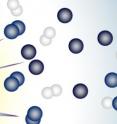Nitrogen fingerprint in biomolecules could be from early sun
Chemical fingerprints of the element nitrogen vary by extremes in materials from the molecules of life to the solar wind to interstellar dust. Ideas for how this great variety came about have included alien molecules shuttled in by icy comets from beyond our solar system and complex chemical scenarios. New experiments using a powerful source of ultraviolet light have shown that no extra-solar explanation is needed and the chemistry is straight forward, scientists from the University of California, San Diego, Hebrew University and UCLA report in the early online edition of the Proceedings of the National Academy of Sciences the week of September 29.
Nitrogen occurs in two stable forms. Nitrogen-14, with an equal number of protons and neutrons in its nucleus, is most abundant. Nitrogen-15, with an extra neutron, is far more rare, but biological molecules like proteins have larger proportions; they're enriched in nitrogen-15 relative to the nitrogen gas in Earth's atmosphere. And Earth's atmosphere itself has relatively more nitrogen-15 than other sources, such as the solar wind and Jupiter's atmosphere.
Samples from the icy comet Wild 2, retrieved by NASA's Stardust mission, and several kinds of meteorites also have relatively more nitrogen-15, and within the inhomogenous mix that makes up stony meteorites are inclusions, individual crystals that can have extremely high proportions of nitrogen-15. These observations led to the idea that the building blocks of life could have been 'seeded' on Earth, delivered perhaps by comet.
The new experiments render that hypothesis unnecessary. "We can generate this nitrogen enrichment inside the solar system. You can form all these building blocks of life inside our solar system. You don't have to bring the pieces in from outside," said Subrata Chakraborty, a project scientist in chemistry at UC San Diego and lead author of the report.
By shining a bright beam of very short wave ultraviolet light through nitrogen and hydrogen gas, Chakraborty and colleagues generated ammonia with drastically skewed ratios of nitrogen-15 relative to that found in the initial gas, which matched that of Earth's atmosphere. Pairs of nitrogen atoms -- the molecules of the gas -- were more likely to be split by UV photons if one or both atoms are the heavier version. Those freed nitrogen atoms recombined with hydrogen to form ammonia.
Ammonia molecules, a nitrogen atom bound to three hydrogen atoms, makes up a fundamental chemical group, the 'amines' the characterize amino acids, which link up in long chains to form proteins. They also join aromatic rings of carbon to form nitrogenous bases, the information carrying components of DNA and RNA. And RNA is how many think life got its start.
Light like this, with wavelengths this short, doesn't make it to Earth anymore. It's deflected by Earth's atmosphere. In fact, the experiments took place in a custom-engineered vacuum chamber aligned with the Lawrence Berkeley National Laboratory's Advanced Light Source synchrotron and were a challenge to pull off.
The chemical events that produced amines with extra nitrogen-15 would have happened long ago, probably in the icy outer reaches of the early solar nebula said Mark Thiemens, professor of chemistry at UC San Diego who directed the work. "It's the right time for this to have happened: before planets, before life."
Additional authors include Harel Muskatel of Hebrew University in Jerusalem, Teresa Jackson of UC San Diego, Musahid Ahmed of Lawrence Berkeley National Laboratory and R.D. Levine of Hebrew University and UCLA. NASA's Cosmochemistry and Origins of Solar System programs funded this work. The U.S. Department of Energy supports the operation of the Advanced Light Source.
Source: University of California - San Diego
Other sources
- Nitrogen fingerprint in biomolecules could be from early sunfrom Science DailyTue, 30 Sep 2014, 10:31:07 UTC
- No need for extrasolar delivery by comet: Nitrogen fingerprint in biomolecules could be from early Sunfrom PhysorgMon, 29 Sep 2014, 19:20:27 UTC
